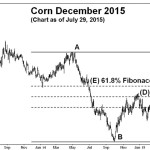It took the corn market three weeks to rally 75 cents per bushel and only two weeks to plummet just as far. When markets go down faster than they go up, farmers may have a difficult time taking advantage of a steep market rally like this. Farmers get busy and may not have got around





